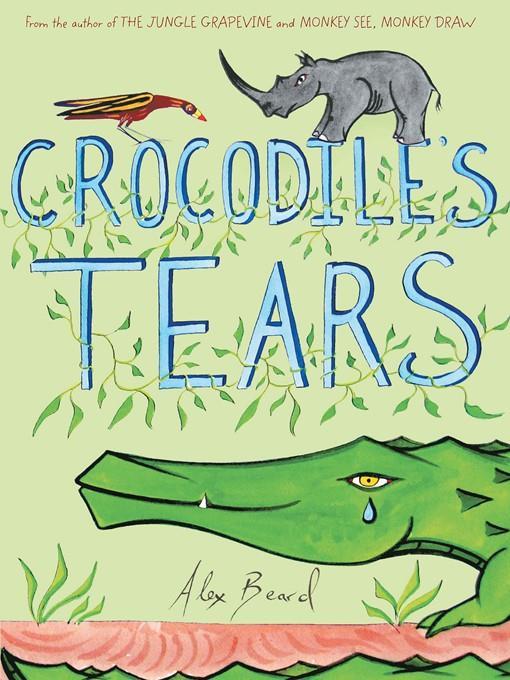
Crocodile's Tears
کتاب های مرتبط
- اطلاعات
- نقد و بررسی
- دیدگاه کاربران
نقد و بررسی

November 14, 2011
More pointed than Beard’s The Jungle Grapevine and Monkey See, Monkey Draw, this offering also showcases his expressive, angular renderings of African animals. Working in pen-and-ink and watercolor, Beard uses wispy, swirling lines and bold shapes to create sky and flora. In the foreground, Rhino and Tickbird try to determine why Crocodile is crying. Afraid to approach him, the two go in search of “a wise golden eagle,” who suggests that Crocodile might miss the elephants.
“heir trumpets rarely sound anymore,” the eagle says, adding, “If you can find an elephant, you could ask him” about Crocodile’s distress. “If you can find...” is the repeated, operative phrase in the gentle if somewhat poky narrative, which sends Rhino and Tickbird from animal to animal, some of which (Beard explains in a note) are endangered, but all of which live in an environment “under siege.” The
idiomatic meaning of “crocodile tears” isn’t mentioned, but lest things seem too dire, Beard delivers a playful twist ending that reminds readers that a crying crocodile is still a crocodile. A photo-essay about each species underscores the book’s ecological message. Ages 4–8.

December 1, 2011
Rhino and Tickbird's query about why Crocodile cries tears leads them from one animal to another, triggering troubling and provocative questions about Africa's endangered habitats and its vanishing wildlife. As Crocodile cries beside the Mburu River, Rhino asks Tickbird, "Why is Crocodile crying?" Rather than confront wily Crocodile, Tickbird sagely suggests asking a rare golden eagle, who believes Crocodile misses the trumpeting elephants. Rhino and Tickbird proceed to find an old elephant, who thinks Crocodile misses singing tree frogs. A solo tree frog thinks Crocodile misses flitting blue butterflies. A lone butterfly thinks Crocodile misses giraffes crossing the savanna. A single giraffe thinks Crocodile misses cheetahs sprinting across the grasslands. Cheetah thinks Crocodile misses open spaces, and Ostrich refuses to answer, burying his head in the sand. Then Rhino makes the nearly fatal mistake of asking Crocodile why he cries. Beard's strong use of textual repetition emphasizes the somber subtext that explores the "ongoing collapse of the wild and its inhabitants," while his bold signature pen-and-watercolor illustrations rely on line, pattern and color in a primitive style that echoes some African folk art. Like a camera lens, strongly defined borders zero in on the action among Rhino, Tickbird and the endangered animals while droll expressions on animal faces add humorous touches to this cautionary tale. Ecological storytelling at its finest. (author's note, glossary of endangered animals with colored photos) (Picture book. 4-8)
(COPYRIGHT (2011) KIRKUS REVIEWS/NIELSEN BUSINESS MEDIA, INC. ALL RIGHTS RESERVED.)

December 1, 2011
Gr 2-4-A picture book about endangered animals in Africa and the importance of protecting the environment. Rhino is curious about why Crocodile is crying. Tickbird doesn't want to ask him because crocodiles are dangerous and suggests that they ask Golden Eagle, who can fly high and see farther. He sends them to another animal and so on and so on, and all of the responses relate to the effects of human encroachment on their habitat. They finally decide to ask Crocodile himself about his weeping. And in perfect form, he explains that it's one of the things crocodiles do to keep their eyes moist-and then eats Rhino (it's another thing crocodiles do), only to spit him out on the last spread. The illustrations are lovely. The animals loom large and dominate the pages with little detail, emphasizing the grandness of each encounter. Unfortunately, the story slows down in the middle because there are so many animals to consult. In addition, the ecological theme is heavy-handed, but still could be lost on younger audiences who do not understand the concept. An author's note explains Beard's reason for the setting and the animals he chose. A beautiful book, with an important message, but one that goes on a bit too long.-Lia Carruthers, Roxbury Public Library, Succasunna, NJ
Copyright 2011 School Library Journal, LLC Used with permission.

























دیدگاه کاربران